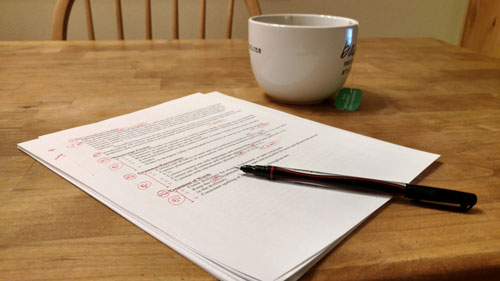One of my favorite aspects of being a manager of Ooligan’s editorial department is the short class we hold every Wednesday. We cover various roles that an editor plays and tasks that they may be expected to complete. During one of these classes, a fellow Ooligan student asked me about other classes they should consider taking if they want to pursue a future in editing. My answer was quick and to the point: design.
Only halfway through completing my studies, I couldn’t know how true those words were. Up until that point, I had worked on several developmental edits and copyedits. These tasks typically require that the editor be in close communication with both the project manager overseeing the manuscript and the manuscript’s author. Our editorial choices were fueled by the author’s creative intent. But all of a sudden we had three manuscripts getting ready to be XML coded, designed, and then proofread.
Some people are surprised to learn that XML is part of the editorial process—I may have been one of them. Now that we’ve completed the XML for At the Waterline and Ricochet River, I can see the importance. First off, coding does require some editorial knowledge (for more information on XML coding, see here). XML tags help show the designer where certain formatting changes need to take place in order to properly conform to the wise tenets of The Chicago Manual of Style.
But secondly, and perhaps more importantly, it is a way for the editor to convey to the manuscript’s interior designer what the author hoped to accomplish. The benefit of XML coding is that we can create tags that are specific to a manuscript’s needs. For example, in Seven Stitches, a young adult novel set in the future after an earthquake wracks Portland, editors were able to indicate via XML tags where a note to the main character should appear to be handwritten or where a disaster alert should receive a special font. Elements like these help create a more dynamic, visually engaging final product. But more than that, they help set the right tone for a particular scene.
Had I not been taking my first design class, I wouldn’t have known exactly what an interior designer was capable of. Nor would I have known how complex the interior design process can be. After the interiors were designed, I had the opportunity to see the final products before we began the proofreading process. It’s always exciting to see a tag like “alert” and “handwriting” applied to the story’s overall aesthetic. And if something doesn’t look precisely how the author may have envisioned things, I can suggest a quick change. In this case, being able to actually speak the same language as the designer makes a huge difference. “I don’t think that character would have had such swirly, loopy handwriting” becomes “We shouldn’t use a script font for this character’s writing.”
I confess that I will likely never have an eye for design. However, being able to work directly with a designer is an important skill for an editor. Along with more clearly presenting the author’s message, it can prevent last-minute fixes during the proofreading stage. At Ooligan, we all strive to work together. Understanding what each department does and how we can each make everyone’s job a little easier is an important asset to keeping the press running smoothly. Maybe next I’ll learn how to write up and design a tipsheet for the marketing department …

